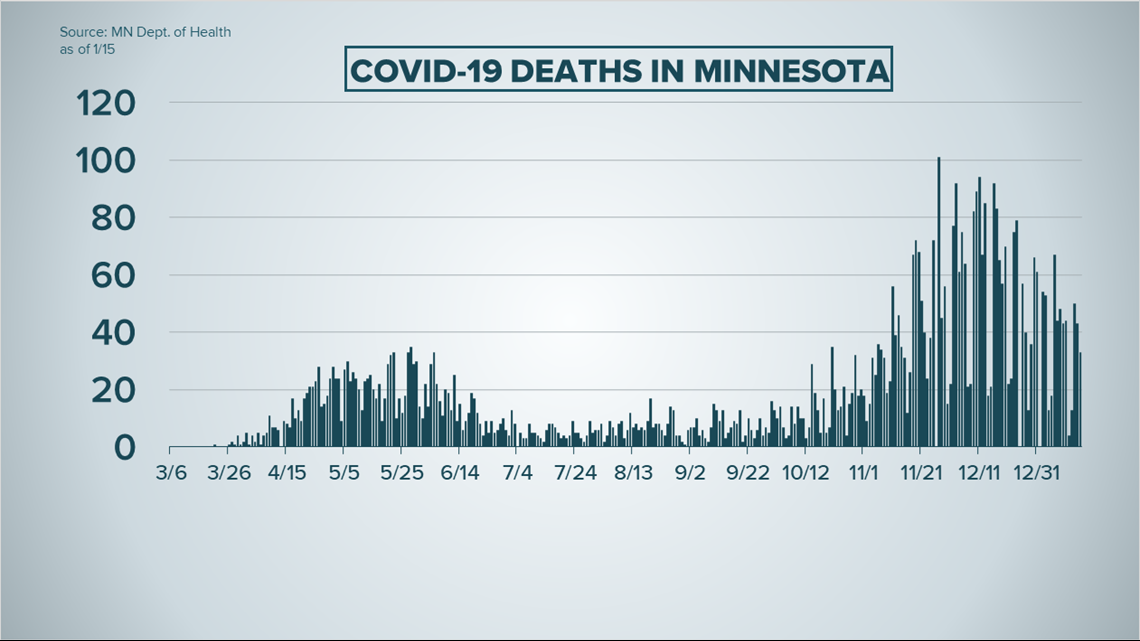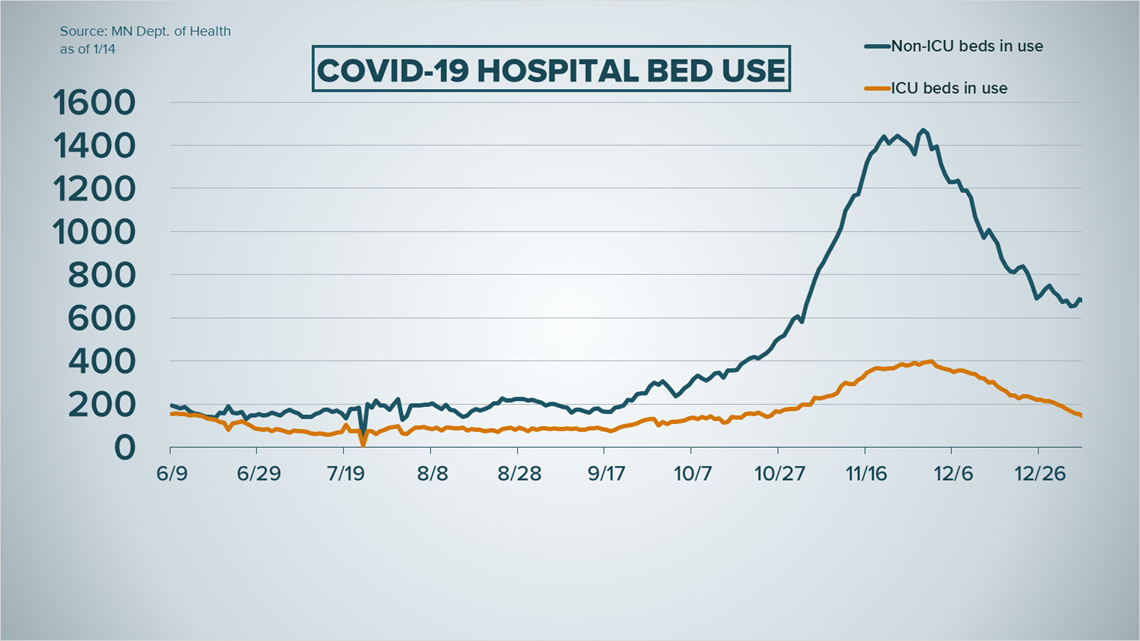ST PAUL, Minn. — Sunday, Jan. 17
- Health officials say 184,943 Minnesotans have at least one COVID-19 vaccine dose, 35,800 have received full vaccine series
- MDH numbers, percentage of doses used ramp up
- Minnesota providers now allowed flexibility to vaccinate some broader groups if they have available doses
- State health officials unveil new vaccine dashboard
- New COVID variant to be an "important variable" in Minnesota's trends
- Wisconsin health officials reported 1,606 new cases, one new death
2 p.m.
Wisconsin's Department of Health Services (WDHS) reported 1,606 new cases Sunday, bringing the total number of cases since the pandemic began to 521,794.
Health officials reported one new death on Sunday as the total number of fatalities rose to 5,451, approximately 1% of those who are infected with the virus.
Wisconsin health officials say a total of 23,076 people have been hospitalized from the coronavirus since the start of the pandemic, about 4.4% of the total number of people who have been diagnosed with the virus.
Of the confirmed cases in Wisconsin, 19% involve people between the ages of 20 to 29, 16% are between 30 and 39, 15% are between 50 and 59, and 14% are 40 to 49. An estimated 11% are between 10 and 19, and another 11% are between 60 and 69.
As of Sunday, Milwaukee County reported the largest number of confirmed cases with 91,534, along with 1,083 deaths. Waukesha County has reported 37,617 confirmed cases and 392 deaths, Dane County has reported 36,433 confirmed cases and 218 deaths, and Brown County has reported 28,282 cases and 178 deaths.
11 a.m.
The Minnesota Department of Health (MDH) reported 1,364 new COVID-19 cases Sunday, along with 40 new deaths.
MDH's COVID-19 case definition includes both antigen testing and polymerase chain reaction (PCR) testing. Positive PCR test results are considered confirmed cases, while positive antigen test results are considered probable cases.
Sunday's new case total includes 1,224 confirmed cases and 140 probable cases.
The total number of Minnesotans who have tested positive for the virus since the pandemic began is now 446,380, with 17,861 of those as antigen test results.
As of Sunday, 184,943 Minnesotans have at least one COVID-19 vaccine dose. A total of 35,800 have received the full series of doses.
MDH says 40 new deaths from the virus were reported. That pushes the total number of fatalities in Minnesota to 5,887.
To date, 23,367 Minnesotans have been hospitalized with the coronavirus since the pandemic started, with 4,879 of them needing care in the ICU.
MDH reports that 427,468 people once diagnosed with the virus have passed the point where they are required to isolate.
Of those who have tested positive, people between the ages of 20-24 account for the most cases with 45,040 cases and three deaths, and ages 25-29 follow with
40,183 cases and six deaths. Those between 85 and 89 years old account for the highest number of fatalities in one age group with 1,119 out of 5,881 cases.
In terms of likely exposure to the coronavirus, MDH says 96,009 cases were the result of community transmission with no known contact with an infected person, and 88,995 had known contact with a person who has a confirmed case.
A total of 36,937 cases involved exposure in a congregate living setting,
7,715 were in a corrections setting, and 946 were in a homeless shelter. MDH data shows 18,091 were linked to an outbreak outside of congregate living or health care.
MDH says 29,537 cases were linked to travel. Health care workers or patients account for 13,232 of diagnosed COVID-19 cases. The source of transmission for 154,918 cases is still unknown or missing.
MDH has prioritized testing for people in congregate care, hospitalized patients and health care workers, which may impact the scale of those numbers. However, now MDH is urging anyone who is symptomatic or even asymptomatic to be tested. Testing locations can be found online.
Hennepin County has the most COVID activity in the state with 92,747 cases and 1,474 deaths, followed by Ramsey County with 39,820 cases and 736 deaths, Dakota County with 32,876 cases and 338 deaths, and Anoka County with 30,877 cases and 363 deaths.
Full data, including a breakdown of PCR and antigen test totals in some categories, can be found on MDH's website.
Saturday, Jan. 16
The Minnesota Department of Health (MDH) reported 1,529 new COVID-19 cases Saturday, along with 37 new deaths.
MDH's COVID-19 case definition includes both antigen testing and polymerase chain reaction (PCR) testing. Positive PCR test results are considered confirmed cases, while positive antigen test results are considered probable cases.
Saturday's new case total includes 1,372 confirmed cases and 157 probable cases.
The total number of Minnesotans who have tested positive for the virus since the pandemic began is now 445,047, with 17,729 of those as antigen test results.
MDH says 37 new deaths from the virus were reported. That pushes the total number of fatalities in Minnesota to 5,887.
To date, 23,291 Minnesotans have been hospitalized with the coronavirus since the pandemic started, with 4,868 of them needing care in the ICU.
MDH reports that 425,253 people once diagnosed with the virus have passed the point where they are required to isolate.
Of those who have tested positive, people between the ages of 20-24 account for the most cases with 44,919 cases and three deaths, and ages 25-29 follow with
40,098 cases and six deaths. Those between 85 and 89 years old account for the highest number of fatalities in one age group with 1,112 out of 5,856 cases.
In terms of likely exposure to the coronavirus, MDH says 95,531 cases were the result of community transmission with no known contact with an infected person, and 88,543 had known contact with a person who has a confirmed case.
A total of 36,871 cases involved exposure in a congregate living setting,
7,691 were in a corrections setting, and 944 were in a homeless shelter. MDH data shows 18,168 were linked to an outbreak outside of congregate living or health care.
MDH says 29,317 cases were linked to travel. Health care workers or patients account for 13,182 of diagnosed COVID-19 cases. The source of transmission for 154,800 cases is still unknown or missing.
MDH has prioritized testing for people in congregate care, hospitalized patients and health care workers, which may impact the scale of those numbers. However, now MDH is urging anyone who is symptomatic or even asymptomatic to be tested. Testing locations can be found online.
Hennepin County has the most COVID activity in the state with 92,491 cases and 1,470 deaths, followed by Ramsey County with 39,703 cases and 735 deaths, Dakota County with 32,788 cases and 331 deaths, and Anoka County with 30,811 cases and 360 deaths.
Full data, including a breakdown of PCR and antigen test totals in some categories, can be found on MDH's website.
The Minnesota Department of Health has said repeatedly that the number of lab-confirmed cases is only the "tip of the iceberg" when it comes to the true number of COVID-19 cases in the state.
The state of Minnesota has set up a data portal at mn.gov/covid19.
Friday, Jan. 15
11 a.m.
Minnesota continues to ramp up vaccinations against COVID-19 across the state, with growth in both vaccines given and percentage of doses used.
Numbers from the new Minnesota Department of Health (MDH) dashboard say 162,040 Minnesotans have received at least one dose of vaccine, and 24,745 have completed the two-dose series. Doses shipped to Minnesota health care providers now sit at 404,650, with another 106,300 shipped as part of the federal CDC long-term care vaccination program.
In all, MDH says nearly 37% of all COVID-19 vaccine doses received by the state have been used, and on Thursday health officials gave guidance to health care providers that they can began vaccinating people outside of Phase 1a who are over age 65.
MDH says 1,640 new cases of the virus were recorded in the last day, based on 46,861 tests (41,568 PCR, 5,293 antigen) performed in private and state labs. That brings the total since the start of the pandemic to 443,562 cases, with 17,577 of those based on antigen tests.
Health officials consider a positive PCR test a confirmed COVID case, while a positive antigen test is considered a probable case.
In the interest of testing participant and site staff safety, COVID-19 testing at the following community sites has been impacted due to winter weather conditions:
- Albert Lea: CLOSED ALL DAY 1/15
- Hutchinson: CLOSED ALL DAY 1/15
- Mankato: CLOSED ALL DAY 1/15
- Morris: CLOSED ALL DAY 1/15
- Worthington: CLOSED ALL DAY 1/15
Another 33 Minnesotans have died from coronavirus, pushing total fatalities to 5,850. Of those deaths 3,734, or 64%, are tied to assisted living or long-term care settings.


Hospitalization numbers across the state continue to drop steadily. As of Thursday 612 people were being treated for COVID-19 in Minnesota hospitals, with 125 of them in the ICU. In the Twin Cities metro, non-ICU bed availability remains quite low at 3.1% (116 beds open in the system) and ICU beds only slightly better at 6.8% (47 beds open).
In total 23,185 people have been hospitalized in the Twin Cities since the start of the pandemic, with 4,850 requiring treatment in the ICU.
MDH says 422,289 people once diagnosed with the virus have passed the point where they are required to isolate.


Young adults continue to make up the largest number of COVID cases. Those ages 20 to 24 now account for 44,769 cases and three fatalities, while people between 25 and 29 have recorded 39,978 cases and six deaths. The largest group of fatalities from the virus involves those from 85 to 89, with 1,105 deaths in 5,841 diagnosed cases.
Hennepin County has reported the most COVID activity with 92,172 cases and 1,468 deaths, followed by Ramsey County with 39,534 cases and 730 deaths, Dakota County with 32,680 cases and 325 deaths, and Anoka County with 30,733 cases and 358 fatalities.
Cook County in northeastern Minnesota has registered the least COVID activity with 113 cases and zero deaths.
Thursday, Jan. 14
2 p.m.
The Minnesota Department of Health (MDH) is telling providers that they can broaden some vaccination groups if they have available doses.
Following the changes in federal guidance on vaccine administration, Health Commissioner Jan Malcolm said, MDH informed providers on Thursday that they can begin to provide vaccines to broader categories of people, including those 65 years of age and older.
That announcement is intended to allow providers to use their doses as quickly as possible, Malcolm said.
"We've been hearing feedback from some of our partners, that ... have made good progress in getting through some of the first stages of this vaccine rollout," Malcolm said. She said those providers are asking for flexibility to start vaccinating some of the next group of Minnesotans that will be eligible.
"We are approaching the end of our earliest stages of the vaccine rollout and are pleased with the progress that's been made," Malcolm said.
Malcolm said MDH is beginning to vaccinate in assisted living facilities, after making good progress in skilled nursing facilities and with frontline health care workers.
"We have far more Minnesotans eligible for getting the vaccine than we have doses available from the federal government," Malcolm said. "Now we really need the federal government to step up and supply us with additional doses of vaccine to make that possible."
Malcolm clarified that Minnesota is not moving to the next phase of vaccinations. MDH is just offering flexibility to providers who have made good progress through the priority tiers and want to use the extra doses they have available.
"We want to remove any barriers to their use," she said.
Malcolm promised to have more information about the next priority groups in Minnesota in the coming days.
"We will be communicating much more broadly with Minnesotans about how we will be making more opportunities available," Malcolm added. "And our ability to actually provide vaccine to those expanded population groups ... is going to depend on how quickly the supply of those vaccines can ramp up."
On Thursday's regular media briefing call, Malcolm reported that nearly 1,600 new COVID-19 cases were reported on Thursday, slightly over Wednesday's total, on a much higher testing volume than Wednesday.
Hospital bed use in Minnesota went down by 20 beds in total, Malcolm said.
The seven-day rolling average of Minnesotans admitted to the hospital with COVID-19 has been stable and declining.
Due to winter weather, an MDH spokesperson said some COVID-19 community testing sites are closing early Thursday. Albert Lea is closing at 3:30 p.m., Morris closing at 2:30, Worthington closing at 3:30.
Dr. Ruth Lynfield, the state epidemiologist, provided an update on multisystem inflammatory syndrome in children (MIS-C). She said Minnesota has seen 56 confirmed cases of MIS-C, and no deaths. The average age is 7 and a half years old, but the range is wide. Seventy percent are male, and MDH continues to see a racial disparity. Sixty percent are Black or Hispanic children.
"We are seeing more MIS-C cases now than last fall, however I want to reminder you that it is still extremely rare.
The 56 cases come out of more than 70,000 COVID-19 cases among children in Minnesota - that's less than one-tenth of 1%, Lynfield said.
The similar syndrome in adults, MIS-A, appears to be related to COVID-19, occurring in adults older than 21. It is thought to be even more rare than MISC, Lynfield said. She said MDH has heard of five cases in Minnesota.
Regarding the new COVID-19 variant that originated in the UK and was recently identified in Minnesota, Malcolm said the virus strain is an "important variable."
She said while recent trends in Minnesota have stabilized, the new variant could have an impact on case growth moving forward.
"We don't have any specific projections that we've done about what this might do to case growth, but it's certainly one among many variables," she said.
Malcolm encouraged Minnesotans to continue to pay close attention to social distancing, masking, staying home when sick and other public health guidance.
"There is no new strategy above and beyond the strategies that we have been employing and that we know are effective," she said.
11 a.m.
The number of new COVID-19 cases in Minnesota remains steady, according to data released Thursday by state health officials, but the virus claimed an additional 43 lives in the last day.
Minnesota Department of Health (MDH) statistics say reports from around the state show 1,598 more people have tested positive for coronavirus, based on results from 36,678 tests (32,982 PCR, 3,696 antigen) processed in private and state labs. Testing volume was up from numbers reported in recent days.
Health officials consider a positive PCR test a confirmed COVID case, while a positive antigen test is considered a probable case.
The new cases reported Thursday bring Minnesota's total to 441,935, of which 17,351 are attributed to antigen tests.
MDH says 43 more people have died from COVID-19, bringing fatalities since the arrival of the pandemic to 5,817. Of those deaths 3,716, or 64% are tied to long-term care or assisted living settings.


The department's new vaccine dashboard says 153,332 Minnesotans have received at least one vaccine dose, while 15,082 have completed the two-dose series. Those people are mostly front line health care workers, first responders and those from vulnerable populations.
Minnesota health care providers have received 400,450 doses of vaccine from suppliers as of Wednesday, and the CDC has shipped an additional 104,900 doses as part of a long-term care vaccination program. MDH says of the doses the state has received, 33.5% have been administered.
As of Wednesday 645 hospital beds across the state are being used to treat COVID-19 patients, with 131 of those beds being in the ICU. Bed availability is lowest in southeastern Minnesota and the Twin Cities metro. Twin Cities hospitals report just 3% of non-ICU beds are currently open (111) while 7.1% of beds in their ICUs are available (49).
Total hospitalizations since the onset of the virus now stand at 23,113, with 4,836 of those patients requiring care in the ICU.
MDH reports that 420,919 people who at one time tested positive for coronavirus have recovered to the point they no longer need to be isolated.
Young adults between the ages of 20 to 24 make up the largest group of the state's COVID cases with 44,632 and three deaths, followed by their 25 to 29-year-old counterparts with 39,844 cases and six deaths. People between 85 and 89 account for the largest grouping of deaths with 1,099 deaths in 5,819 confirmed cases.
Hennepin County continues to report the most COVID activity with 91,859 cases and 1,461 deaths, followed by Ramsey County with 39,405 cases and 729 deaths, Dakota County with 32,551 cases and 324 deaths, and Anoka County with 30,638 cases and 354 fatalities.
Cook County in northeastern Minnesota has the least COVID activity with 113 cases and zero deaths.
KARE 11’s coverage of the coronavirus is rooted in Facts, not Fear. Visit kare11.com/coronavirus for comprehensive coverage. Have a question? Text it to us at 763-797-7215. And get the latest coronavirus updates sent right to your inbox every morning. Subscribe to the KARE 11 Sunrise newsletter here. Help local families in need: www.kare11.com/give11.
The state of Minnesota has set up a data portal online at mn.gov/covid19.

